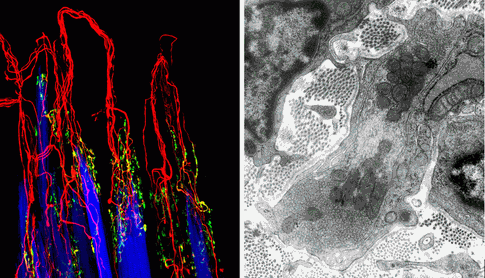Research Focus
Sensory and Motor Innervation of Mammalian Eye Muscles
The brain needs visual information from the retina and additional information about the eye position to exactly localize objects in the surrounding space. It is supposed that such eye position information comes from specialized receptors (proprioceptors) in the eye muscles. The most well-known proprioceptors are muscle spindles and Golgi tendon organs. Over the past several years we have analyzed these proprioceptors in eye muscles of men and other mammals. During the last years we have focused on palisade endings. Palisade endings are special nerve endings exclusively found in eye muscles of mammals. For a century they have been supposed to be sensory organs. Interest palisade endings was reignited when our molecular studies and neuronal tracing studies showed that palisade endings are cholinergic and originate from the motor nuclei in the brain stem. These findings are more compatible with a motor function of palisade endings.
Main Objectives
Today the function of palisade endings is still an open question. The long-term objective is to determine the function of palisade endings by molecular biological and physiological studies. Findings might help to better understand oculomotor disorders like strabismus.

